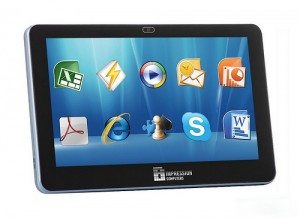This post is a follow-up to my blog post ‘The 1-minute mLearning panel summary’. (You can watch the IATEFL Glasgow panel discussion here). That post dealt with the panel’s responses to questions from the chair (Lindsay Clandfield). This follow-up post summarises the issues brought up by the audience at this same panel event. These issues reflect, I think, (some) general concerns that educators have about the implementation of mobile learning. Below I’ve summarised some of the views of the panel, and added my own at points.
- What’s better – BYOD (bring your own device) or class sets of mobile devices?
Clearly there are issues with BYOD (and you can find a good set of resources related to the topic on Scott Newcomb’s blog here), not least that of compatibility across platforms. But a key point in favour of BYOD is that of ownership and personalisation. Students using their own devices, and being able to take them home, will strengthen the home-school connection for younger learners, and encourage out of class learning for all learners. But we need to remember that for some learners in some contexts, bringing expensive mobile devices to and from school may in fact be unsafe by leaving them open to attack. Miguel Mendoza in Venezuela bought my attention to this in a comment on one of my blog posts last year, when he pointed out that it would be unfair to ask his students to bring smart phones or similar to class as they could well be targeted for mugging.
- What criteria should we use to select ‘good’ mobile learning material?
As with any materials, relevance and coherence are important, and we also need to guide our students through already available content for consumption via mobile devices. Perhaps more interestingly though, we can encourage the use of mobile devices to capture information and record in the field, to document what learners actually need. Most importantly, whatever we decide to do with our mobile devices, we need to ensure that it supports learning. A cool app may be cool – but does it actually help our students learn anything? I think the key questions we ask ourselves about any digital tools or materials hold true for mobile and any other kind of learning materials. I’ve blogged about this in the past, and so have Sue Lyon-Jones and Graham Stanley, among others.
- If students have access to mobile devices, won’t they be tempted to bully each other or tweet offensive things while online in class?
Acceptable Use Policies (AUPs) need to be in place to deal with unacceptable behaviour for younger learners. After all, we expect certain standards of behaviour face-to-face, and online is no exception. We do need to be careful not to tie down things too much. If we limit Internet access because we fear students may misbehave when online, we will end up doing our learners a disservice. For adult learners, online netiquette guidelines can had given or negotiated with students.
- If mobile learning is ‘any time anywhere’, does this imply an increased workload for teachers?
This can be a danger, but there are a number of possible solutions:
- set up rosters e.g. for tutorials/homework help, managed at institutional level
- encourage collaborative learning activities so that learners get on with tasks without the teacher. Effective task design is key here.
- set clear expectations about and limits to when and how often you can be contacted as the teacher
- How do you deal with negative attitudes to mLearning from other teachers?
It’s best to start small. By implementing a pilot project in your institution with only a few classes and teachers who are keen to take part. Good tech support needs to be in place to deal with the nitty-gritty of things like backing up class sets of iPads, installing apps, transferring work from devices to the teacher etc. Pilot project teachers need to be personally supported by a team leader. For larger projects, an online community to discuss and share what is being done, plus regular face-to-face meetings (e.g. monthly or every six weeks) can also be helpful. Any training needs to include the methodology behind the activities/tools being used, not just how to deal with the technology. With younger learners, holding sharing events with parents, and building in learning materials for children to take home on devices can garner important parental support for mLearning projects.
These suggestions are from Gillian Penny’s primary school iPad project, which is carrying out a research project with the University of Hull. This mLearning project is evaluating teachers, students and parents at six-month periods throughout the pilot, and it will examine attainment and also changes in attitude towards the use of mobile devices (unfortunately I can’t find any online documentation about this project).
What about you? What issues do you or your teachers have with implementing mLearning? Please share in the Comments section below!
Nicky Hockly
The Consultants-E
May 2012
If you like these 1-minute Guides, check out:
- The 1-minute mLearning panel summary
- The 1-minute guide to integrating technology into teaching
- The 1-minute guide to the mobile classroom

